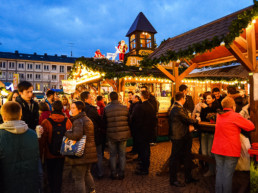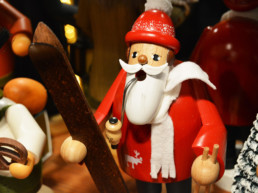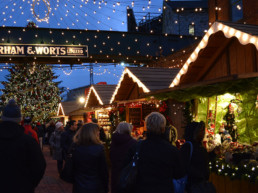Oh, the joys of the Christmas season. That magical time of year when work slows down, family and friends come out of the woodwork, and the onset of winter weather is met enthusiastically with kitschy sweaters rather than outright disdain (looking at you, January). All legitimate reasons to rejoice in my mind, and nowhere is the yuletide celebration more pronounced than at German Christmas Markets, in the country that pretty much invented the traditions and customs we now associate with the holiday.
Visiting German Christmas markets is like stepping back in time; to when the holiday season was about gathering with meaningful friends instead of being too busy to get together; to when you would select a special, one of a kind, locally made gift for a loved one rather than a bunch of generic products at the mall that nobody really needs. If this, along with more tangible aspects like twinkling lights, mulled wine, and the irresistible aroma of roasting nuts, doesn’t get you in a festive mood, then nothing will. Even if you don’t celebrate Christmas, the pre-holiday euphoria is contagious.
If you’re looking to bring the authenticity back to your holidays, I highly recommend making a trip to Germany to visit a few of their iconic Christmas markets. Here are all of my tips gathered throughout visiting dozens of German Christmas markets.
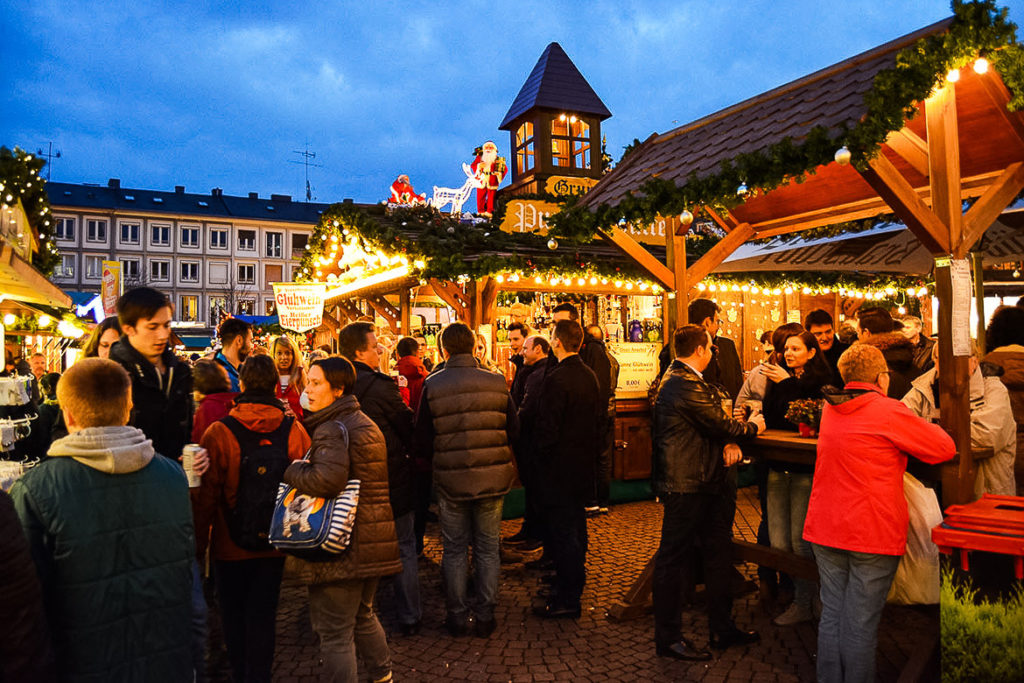
A Comprehensive Guide to German Christmas Markets
The Basics
What: German Christmas markets date back to the 14th century and attract nearly 200 million people a year across the country. There are a few different local names for Christmas market, but most often Christkindlmarkt or Weihnachtsmarkt are used.
Where: Being such a strong tradition in Germany, there are thousands of Christmas markets across the country from local villages to major cities. If you’re headed anywhere (and I mean anywhere) in Germany, chances are there will be some sort of market happening near by.
When: Most of the markets run from late November to Christmas Eve or New Years Eve. This UK based site has the most comprehensive timing and date information that I’ve come across.
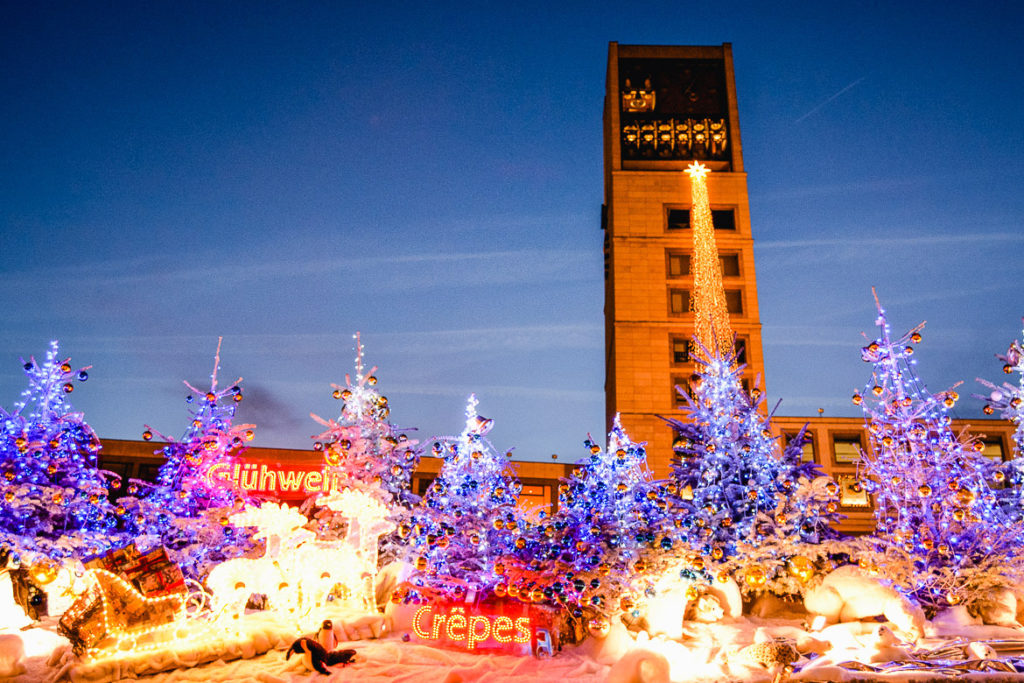
What To Expect at German Christmas Markets:
German Christmas markets are usually set outdoors in idyllic town squares at the centre of the city, often near the Rathaus, or the local town hall in English. At each market there are dozens, and sometimes hundreds, of wooden booths each belonging to various proprietors offering up their unique goods for sales.
Craftsmen sell one of a kind trinkets, woodworkers display handcrafted and ornately decorated nutcrackers, and glassblowers showcase their innate and delicate ornaments. Besides gifts, food and drink stalls are plentiful and integral to the Christmas market experience.
At night, hundreds of shimmering lights and candles create a magical atmosphere and a large, beautifully decorated tree typically stands as the focal point in each town. Another highlight is the Weihnachtspyramide, a Christmas pyramid that is built with multiple layers of festively themed figures that’s on display at most markets. Nativity scenes are also a prominent feature of Christmas markets in Germany.
Most German Christmas markets feature kid and family friendly elements such as rides that range from the typical ferris wheel and carousel to more eccentric options such as small roller coasters.
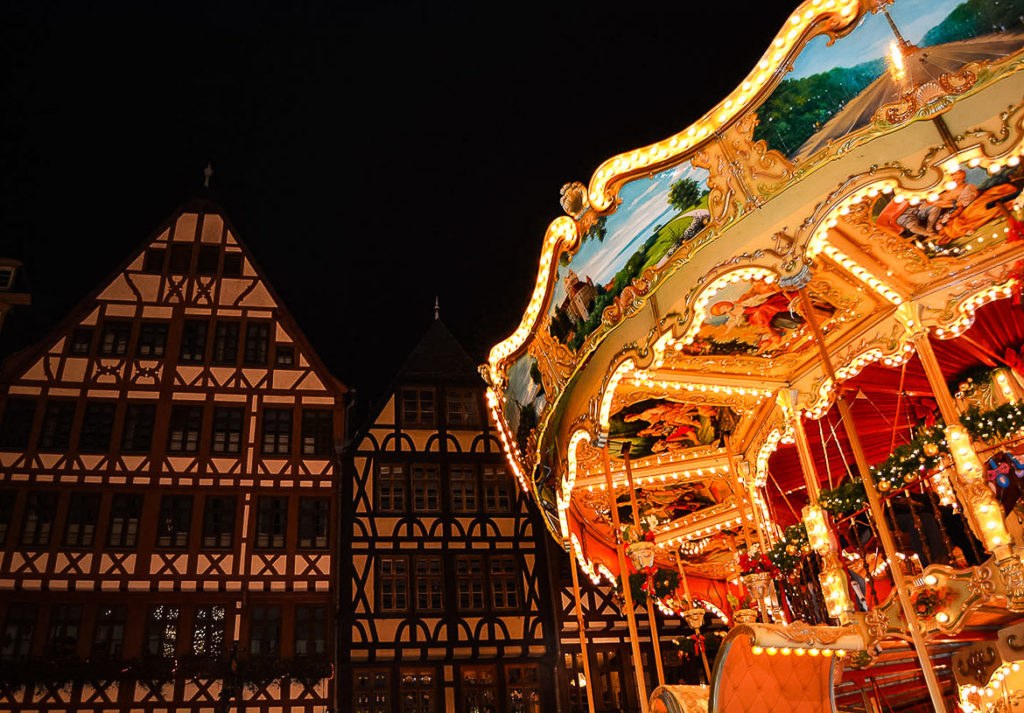
German Christmas markets are first and foremost a social gathering spot for locals. After work and on weekends, friends will gather in the square to catch up and enjoy a drink together, creating a fun, social, and boisterous environment.
What to Eat at Christmas Markets in Germany:
Do not eat before coming to a Christmas market. The waft of delicious foods make it too irresistible to pass up. It’s probably cheaper and more exciting to eat throughout the market than at a proper sit down restaurant.
While some of the food on offer are classic Christmas dishes, particularly the cakes and treats, others are traditional German foods that you would find throughout the country. Although that shouldn’t matter at the end of the day as the hearty fare is particularly complementary to the chilly weather and the boozy drinks.
Wursts: Sausages are serious business in Germany so it should come as no surprise that they are a staple of Christmas market cuisine. Depending on where you are in the country, the type of sausages offered may differ to highlight local specialties. When the sun sets, the smoke cascading off of the schwenkgrill, a large swinging grill, indicates exactly where the sausages are being prepared. Bratwurst is common across Germany, but you should also look to sample other varieties such as Krakauer (spiced Bratwurst) and Käsewurst (sausage stuffed with cheese), as well as be on the lookout for other regional sausage delicacies.
Reibekuchen / Kartoffelpuffer: These fried potato pancakes are the perfect combination of crispy, delicious, and hearty. An order is often three or four pancakes and a side of apple sauce for dipping. They are usually served right out of the fryer so provide a warming effect on a cold night.
Spaetzle: Although strictly speaking spaetzle is a regional dish from Swabia, I’ve happily encountered it at many Christmas markets across Germany. This rich and satisfying egg noodle dish is often made with cheese and onions and can be topped with parsley, fried onions, and speck.
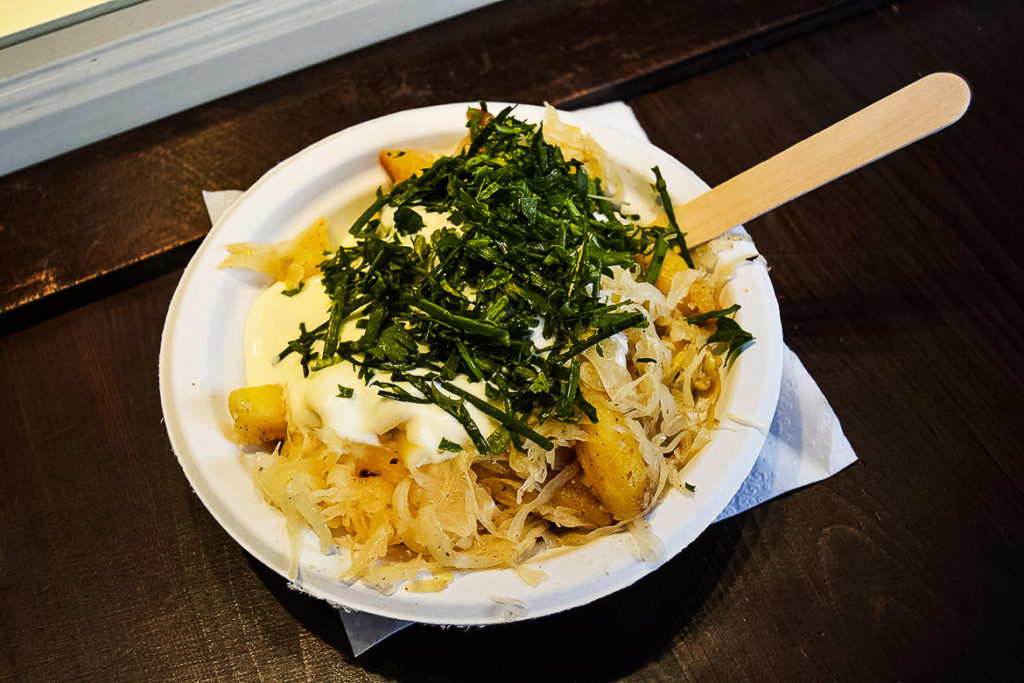
Spanferkel: You’ll likely smell the whole pig roasting on the open spit before you see it. Slowly turning around the open flames for hours, the meat cooks until it’s melt-in-your-mouth tender on the inside and delectably crispy on the outside. Slices are carved off, put on a bun, and doused with mustard.
Steckerlfisch: This simple yet tasty dish of grilled fish on a stick is especially prevalent in Southern Germany. A great alternative for those who don’t eat meat.
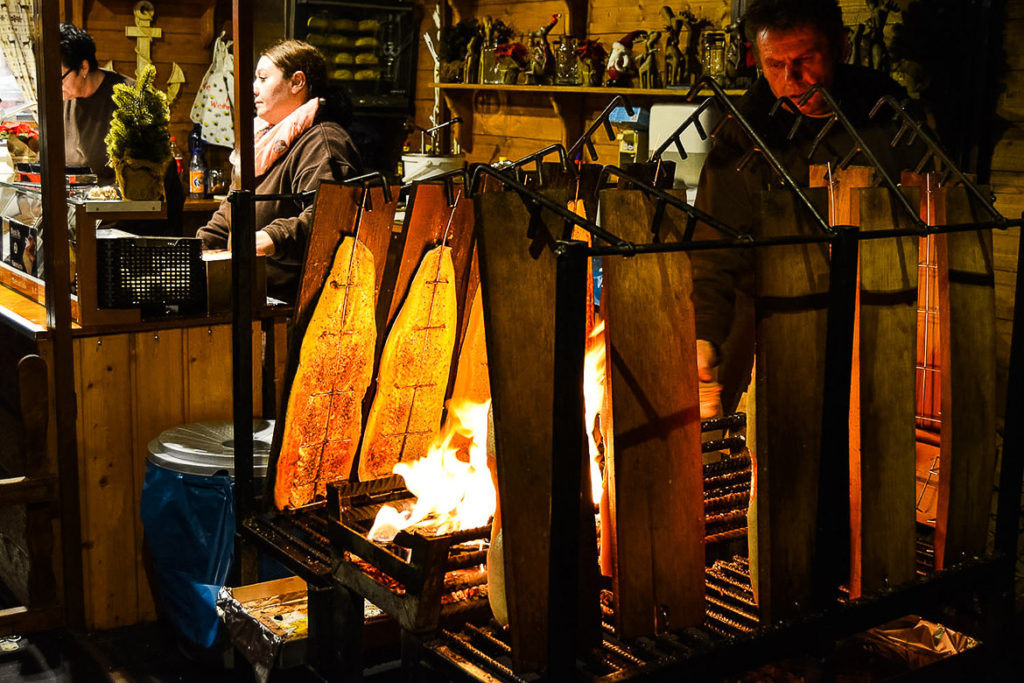
Cheese: I’ve come across various cheese dishes throughout my Christmas market experience. The most prevalent were baked camembert – a huge wheel of camembert that’s breaded, baked, and served with a fruit topping – and the Swiss favourite Raclette – an enormous wheel of cheese that’s melted and scraped onto slices of freshly baked bread, a truly mesmerizing experience to watch.
Flammkuchen: A frequent offering throughout German Christmas markets is this flatbread of sorts. A paper thin crust is most often topped with crème fraîche, onions, bacon, and a sprinkling of green onions. While some markets offer different varieties and toppings much like a pizza, I prefer the classic version as it’s deliciously simple.
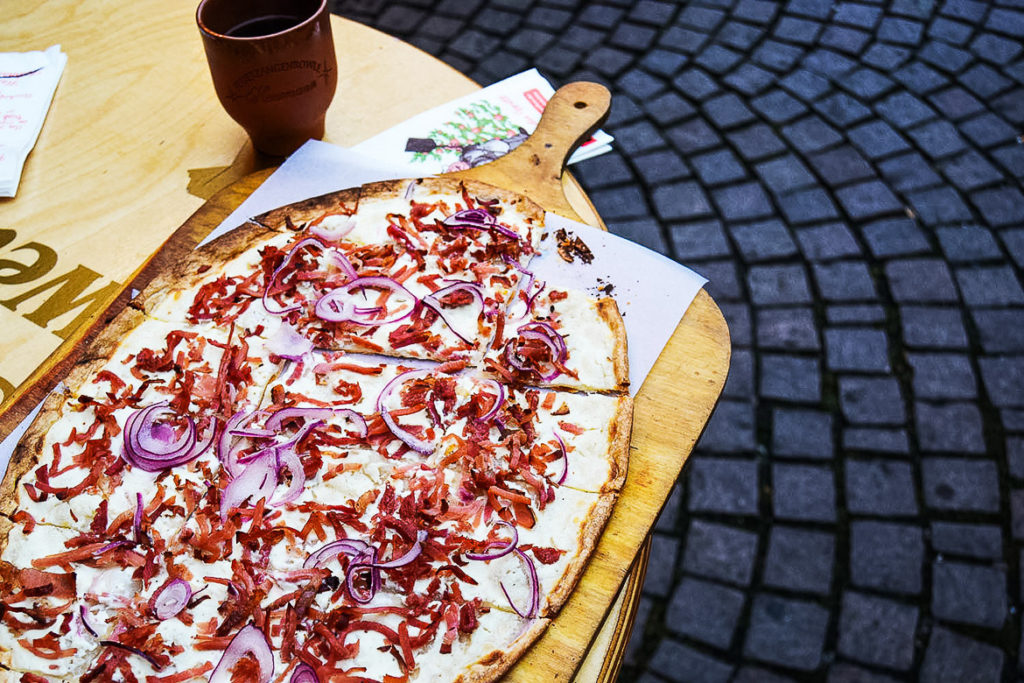
Pfannkuchen: Also known as a Berliner, these are essentially doughnuts with a fruit filling and dusted with powdered sugar. Best when served warm and eaten immediately.
Gebrannte Mandeln: Roasted nuts are a prevalent treat at the markets but almonds are arguably the most popular. The German method involves roasting the nuts with a ton of sugar until nearly burnt and the sugar has crystallized. Be forewarned, this sweet and crunchy snack is highly addictive.
Candies: You’ll come across at least one candy stall at every Christmas market. Most are huge stands with a vast array of candies, sweets, lozenges, chocolates, and nuts of every type and flavour imaginable. Just making a decision on what to buy is difficult as there’s so much choice – chocolate covered marshmallows, candy canes in a myriad of flavours, or decadent candy apples. You’ll want them all!
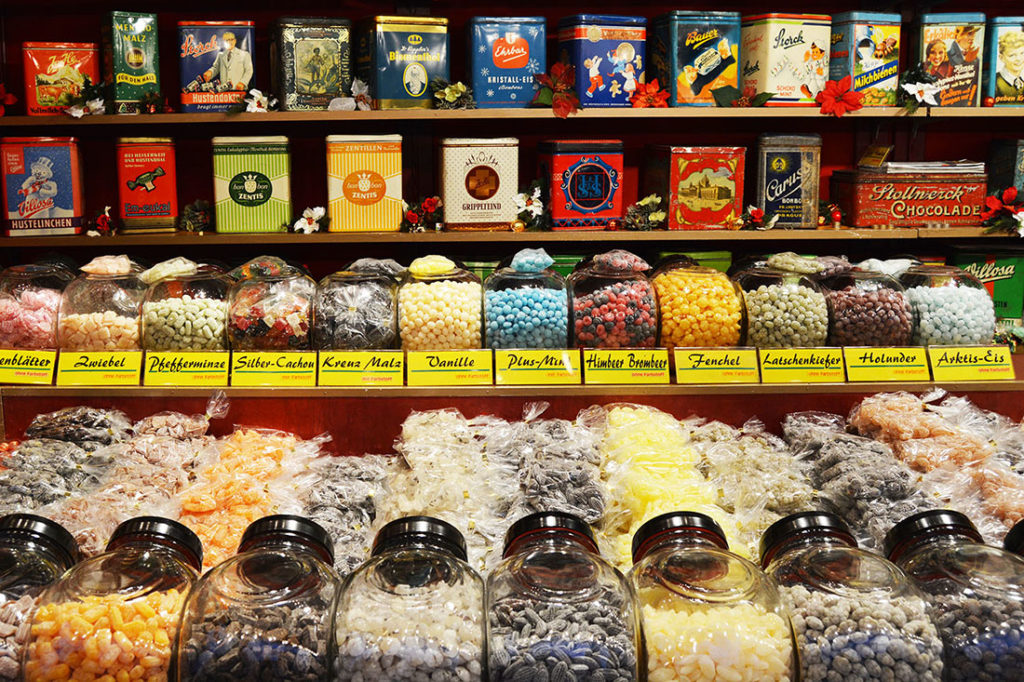
Stollen: This classic Christmas loaf is made with dried fruit and a range of spices and is offered in take home packages to enjoy later or give as a gift.
Lebukuchen: Another classic Christmas treat in Germany, this spiced treat similar to gingerbread is typically eaten in the form of dense but chewy cookies. The large heart shaped cookies with loving phrases that are often associated with German festivals are also made from lebukuchen and can be found at every market.
Crepes: This French export is a popular sweet treat in Germany during the holidays. Cooked fresh on a flat griddle, the crepes frequently feature toppings like Nutella, banana, and jams or more savoury options like meat and cheese.
What to Drink at German Christmas Markets:
As the local Christmas market is a time for Germans to gather and connect with friends, alcohol is a definite favourite. When you buy a drink, you’ll often pay a deposit on the glass in addition to the price of the drink. The deposit, or pfand, is usually between 2-3E and is refunded once you return the mug or glass.
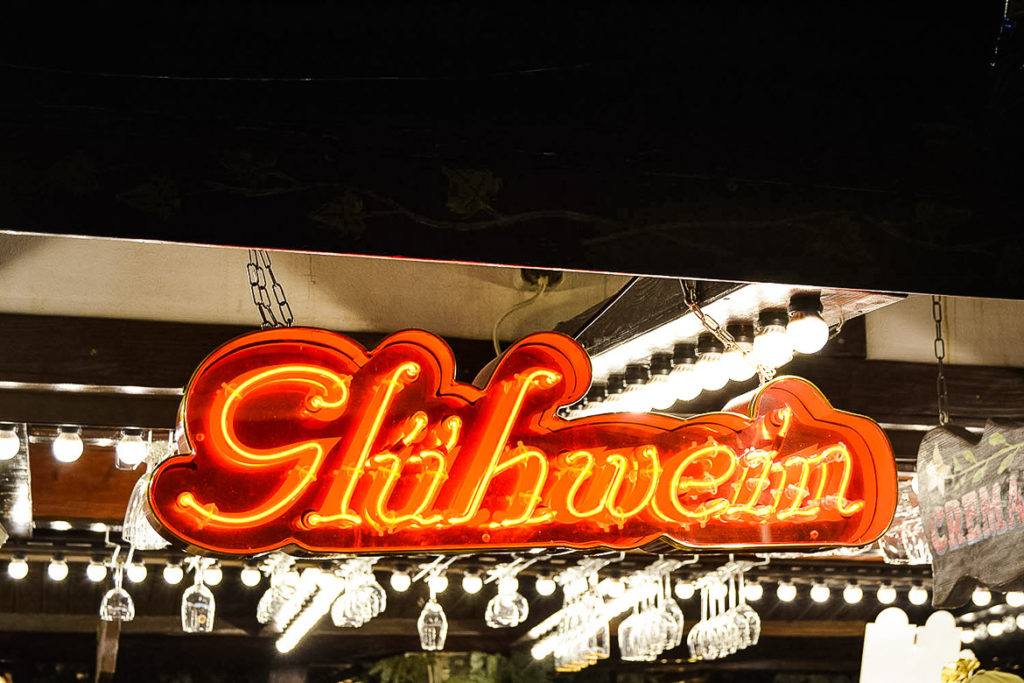
Glühwein: The beverage of choice across the country during the Christmas season. This mulled red wine is served piping hot, making it one of the best ways to get some warmth on a cold night at the market. There are also alternative varieties of glühwein that often accentuate a local or regional wine. I’ve come across weiss glühwein, a white wine variety at many of the markets, as well as Apfel glühwein, a version made with hot apple cider. Be on the lookout for any unique versions wherever you visit and give it a try!
Feuerzangenbowle: Made with mulled wine and rum, this potent concoction is glühwein on another level. A sugarloaf soaked in rum slowly drips into a large copper pot on a hot stove to make this boozy drink. Feuerzangenbowle may be difficult to say but it goes down easy.
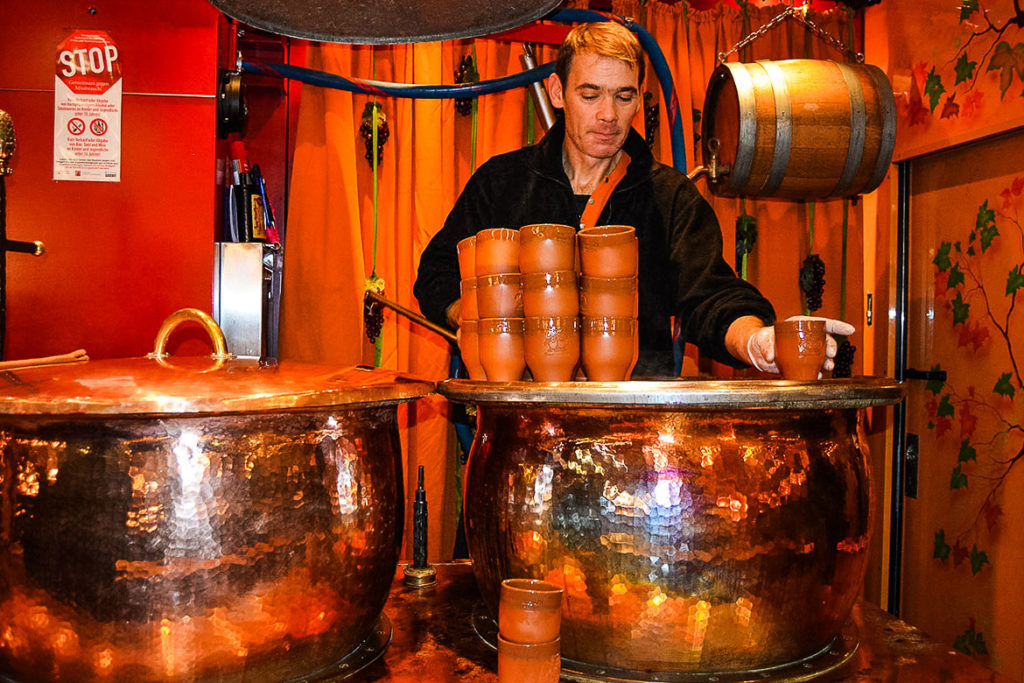
Beer: It wouldn’t be Germany without beer, even if it is relegated to the sidelines in favour of more Christmasy beverages. You can anticipate that there will be beer at least somewhere, being more prevalent at some markets than others. Often the type of beer available will be representative of local breweries, providing an opportunity to sample a few if you visit multiple markets.
Wine: While glühwein is the most popular wine drink across the country during the Christmas season, standard wines are also available, particularly in wine producing regions. I encountered far more people drinking glasses or bottles of wine in Wiesbaden and Stuttgart than anywhere else in Germany.
Honigwein: Mead is a popular offering in the medieval themed markets but also pops up in other towns as well. Made from fermented honey and water, it’s a beverage with a strong history and tradition. Depending on the market, you may come across a booth selling bottles of mead in an insane number of flavours to take with you as a souvenir.
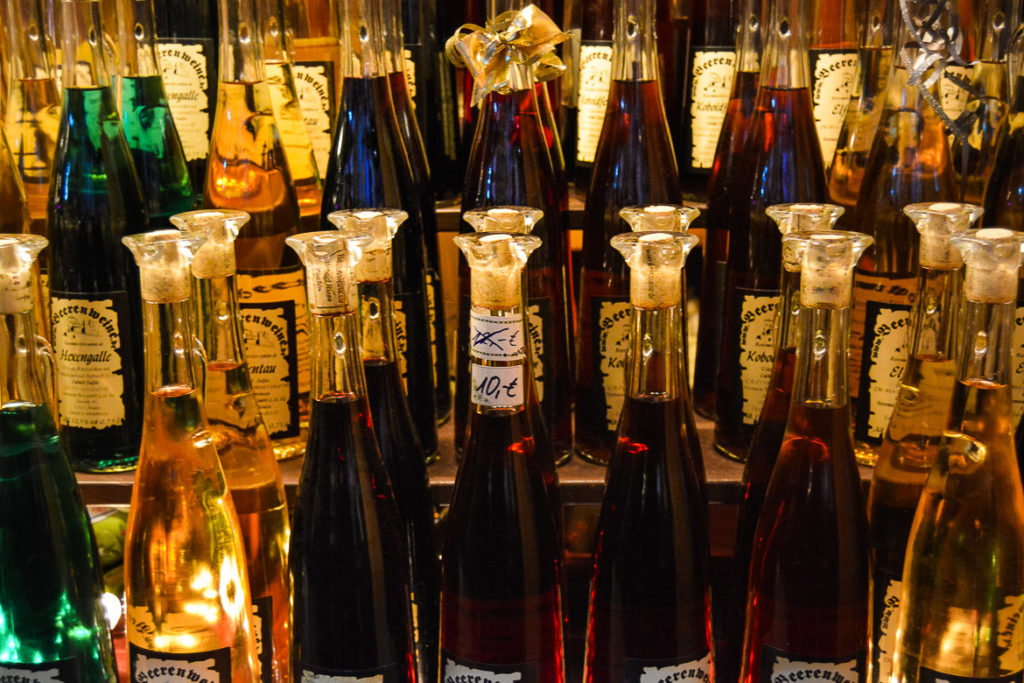
Eierlikor: Although often compared to eggnog, eierlikor is a smooth liqueur made with eggs and brandy. Eirlikor punsch is often served warm and topped with whipped cream.
Local specialties: Always follow the locals’ lead and go for whatever seems to unique to the area. We had the opportunity to try glühbier in Darmstadt, a drink that essentially is to beer as glühwein is to wine.
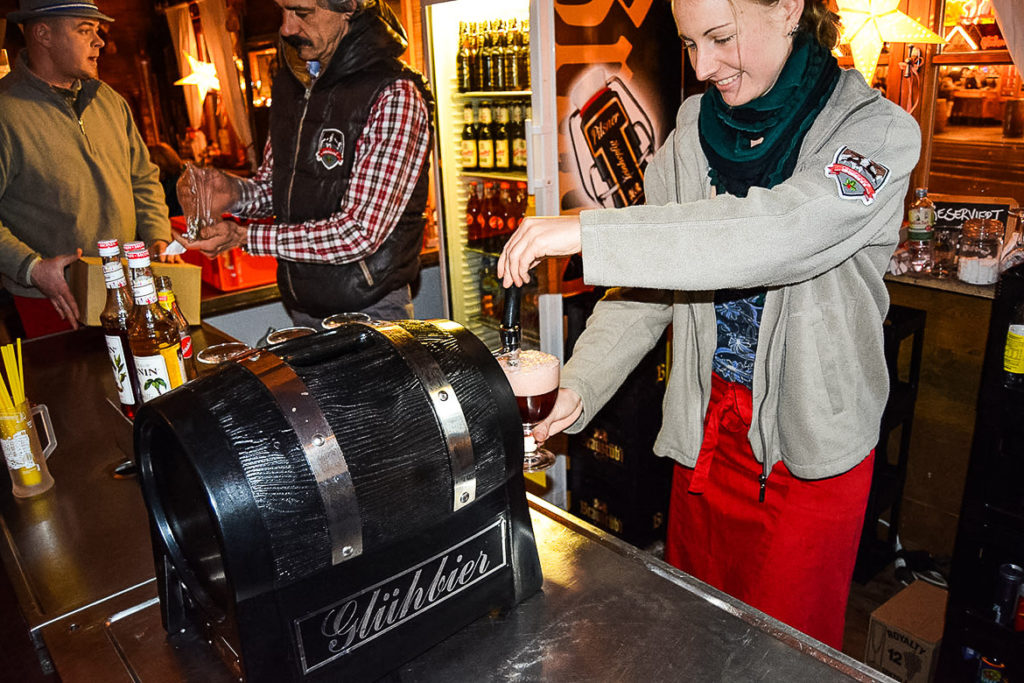
Non alcoholic: While boozy drinks dominate the German Christmas markets, there are non-alcoholic alternatives too. Kid favourite Kinderpunsch is warmed punch made from grape juice, making it essentially a child friendly glühwein. Heisse schokolade is a decadent hot chocolate, often topped with a generous dollop of whipped cream.
What to Buy at German Christmas Markets:
For the most part, German Christmas markets offer an impressive range of unique, one-of-a-kind, and locally produced products. Some of the markets are more commercialized though, particularly those in major cities and near the areas that tourists frequent most, so it’s best to do your research beforehand.
Even at the same market there can be a large discrepancy, with some standard booths across every market while others are truly unique to that city. After visiting a few markets you’ll begin to see both the commonalities and the nuances between them.
Christmas tree ornaments are everywhere at the markets and are a popular buy as German’s don’t decorate their Christmas trees until December 24th. As one would expect, ornaments can differ greatly from booth to booth, and come in a wide array of styles, materials, colours. Part of the fun is traversing the market looking for interesting and unique ornaments to bring home with you.
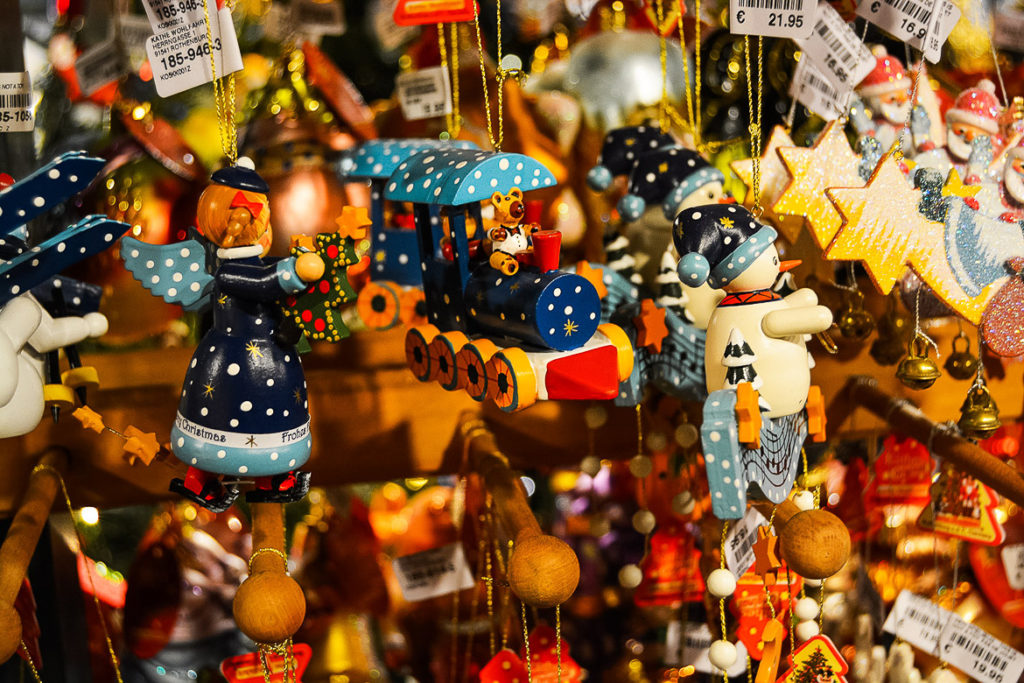
Nutcrackers are a classic symbol of Christmas in Germany and considered good luck to have in the home. Accordingly, you will encounter a magnitude of options, with different sizes, shapes, and figures represented.
Hand carved wooden ornaments, nutcrackers, and figurines are plentiful in German Christmas markets but the best quality items are those from the Ore Mountains in eastern Germany near the Czech border.
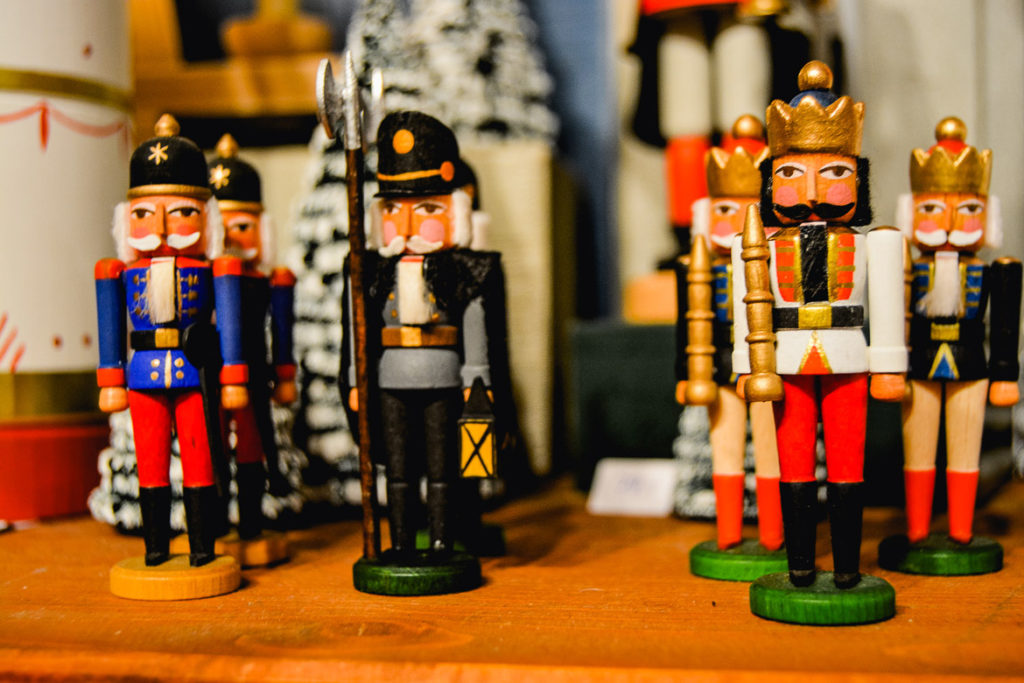
You will find a booth at any German Christmas market worth its salt offering up household items and cleaning supplies. You can often buy all sorts of pots and pans, cooking utensils, brooms, and cleaning brushes. Better buy what you need to get your house in order for all of the holiday entertaining you’ll be doing!
Honey and products made from honey can be found in abundance at German Christmas markets. You will inevitably come across various honey types and flavours, candles made of honey, health and beauty products with honey, honey liqueurs, and a ton of other gifts you never knew could be made with honey.
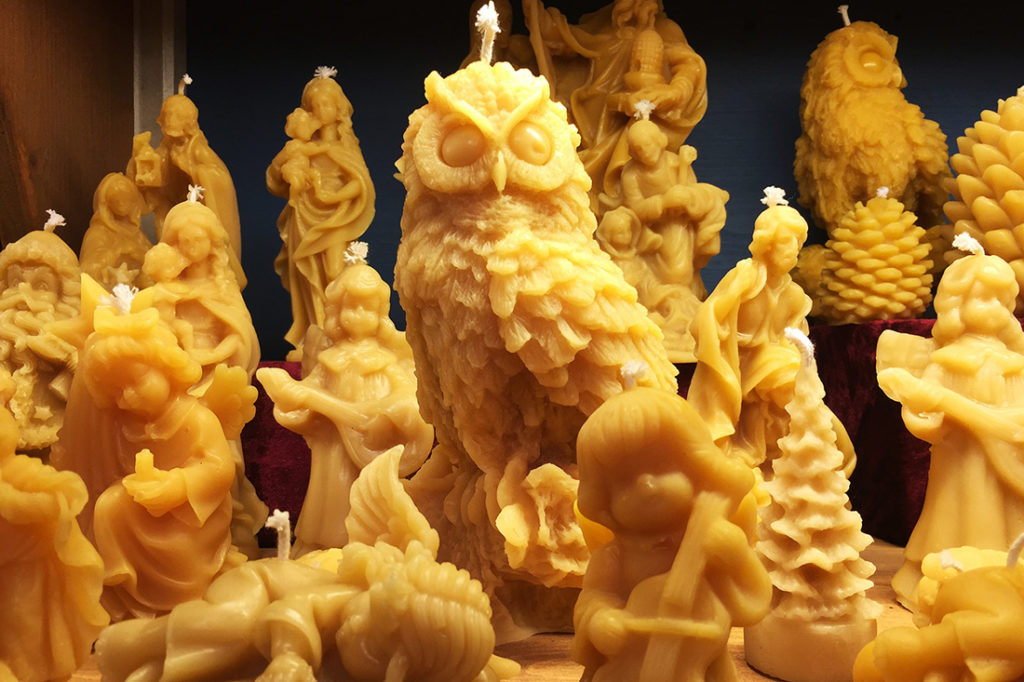
You’re guaranteed to find at least one booth selling truly unique items that you won’t find anywhere else. Our most notable finds include hipster bowties from Wiesbaden, intricate 3D pop-up cards in Cologne, and glass blown animal piggybanks in Darmstadt.
A common theme across the markets are Christmas village miniatures – essentially small porcelain models of typical German homes, buildings, and surroundings that allow you to build your own classic German village at home, if you want.
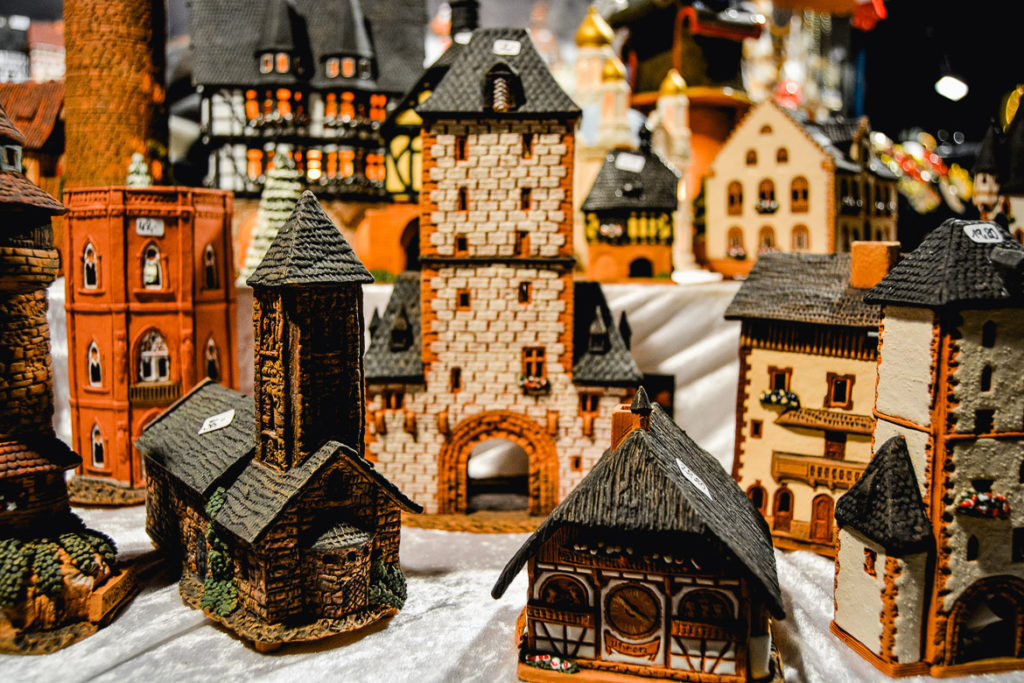
Everybody loves a sweet treat, especially during the holiday season. Candy and cookies are on display nearly everywhere you look at German Christmas markets and most regions have their own specialties: Printen is a spicy gingerbread from Aachen, zimtsterne are star shaped cinnamon cookies originating from Swabia, and vanillekipferl are biscuits coated with vanilla sugar.
How To Make The Most of German Christmas Markets:
Some Christmas markets in Germany are more touristy than others, especially in cities that attract a lot of visitors such as Munich, Nuremberg, and Cologne. Take this into account when you’re planning your visit and think about including off-the-beaten-path spots into your travels.
The vibe at Christmas markets in smaller towns is often much different than what you’ll find in larger cities. Try incorporating both small and large cities into your travel plans to experience both ends of the spectrum.
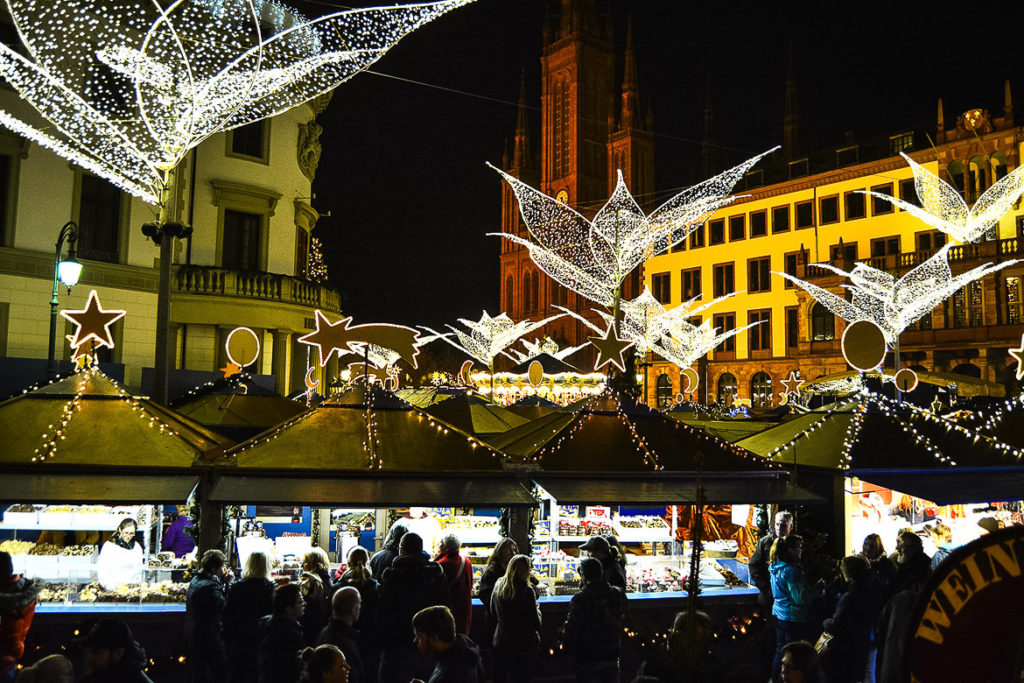
Although some assume that to see one Christmas market in Germany is to see them all, the variation between individual Christmas markets in Germany is in fact huge. Many markets have their own unique elements and discovering these nuances is part of the fun of visiting multiple cities during the holiday season. My tip is to base yourself in one place and visit nearby markets to get a few varied experiences.
The German rail system is extensive and efficient so taking the train to visit different markets is the way to go, both for large cities and smaller towns.
Larger cities like Berlin, Munich, and Hamberg have multiple Christmas markets across town, each with their own theme. Look into the various markets in advance as the ones in the centre of the city are often the most touristed and least authentic.
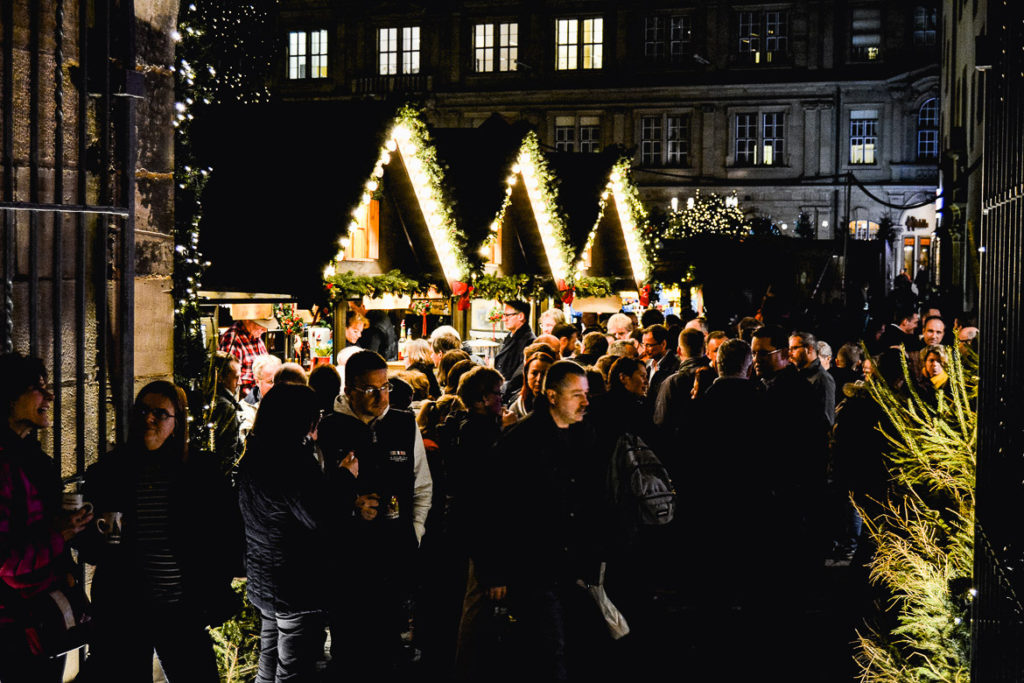
Many markets have live musical performances and parades. Often you can find a schedule online (in German) or you can inquire when you’re there. A harmonized choir singing traditional yuletide carols perfectly encapsulates the Christmas feeling so don’t miss out!
Some markets are huge and stretch across several blocks of the city. Others may be more compact but don’t underestimate the amount of walking you’ll be doing while checking out all of the booths and food offerings. If you’re taking the train into the city, they’re often a bit of a trek to the market so you’ll be getting some distance in there as well. Ultimately, be smart and wear comfy shoes.
The weather in December varies throughout the country and depends on the year, sometimes it’s quite frigid and other times unseasonably warm. You’ll be spending a significant amount of time outdoors at every market so dress in layers and bring a hat, scarf, and gloves. If you’re not dressed for the weather, there’s no amount of glühwein that will warm you up.
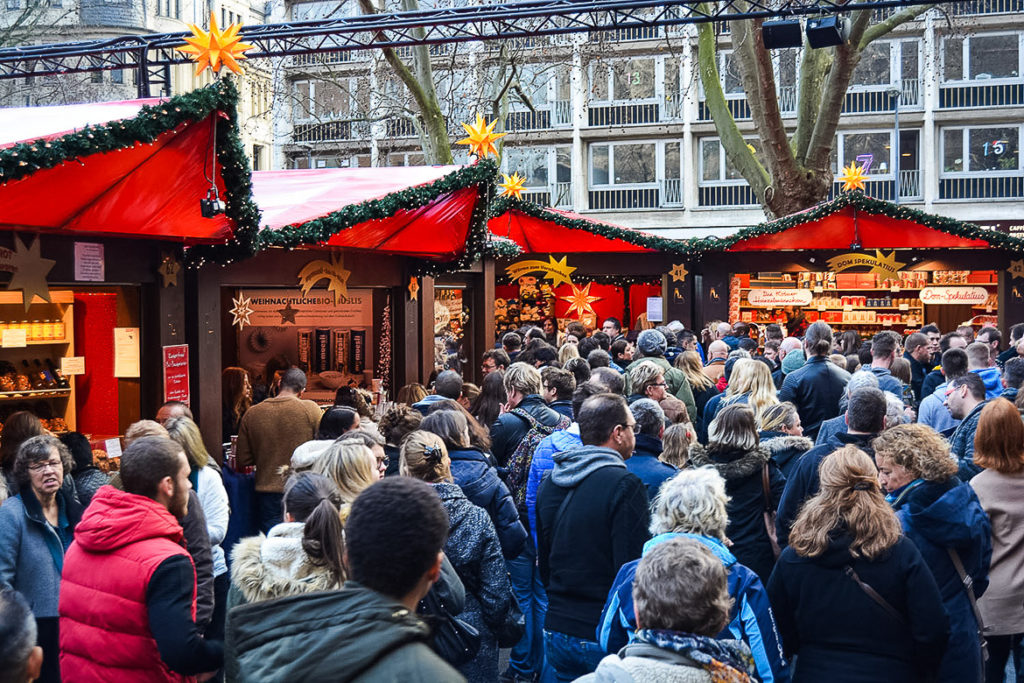
The crowds can be intense. Locals love spending time at their Christmas market and it’s often the spot to go for an afterwork drink with colleagues or to meet friends on the weekend. Pair that with the burgeoning tourist interest in German Christmas markets and it amounts to a ton of people. The walkways can be jammed with people, making it difficult to move and claustrophobic at times. No matter how bad it is, be patient and polite as everybody’s in the same boat. If you don’t do well with crowds, try visiting earlier in the day when it’s less busy.
Each city or town has it’s own commemorative mug to serve glühwein, which changes annually. Essentially, you can collect glühwein mugs from all the different markets you visit. You pay a deposit of a few Euros for the mug when you order, which is a way to ensure that the sellers aren’t at a loss if patrons ‘forget’ to return the cups.
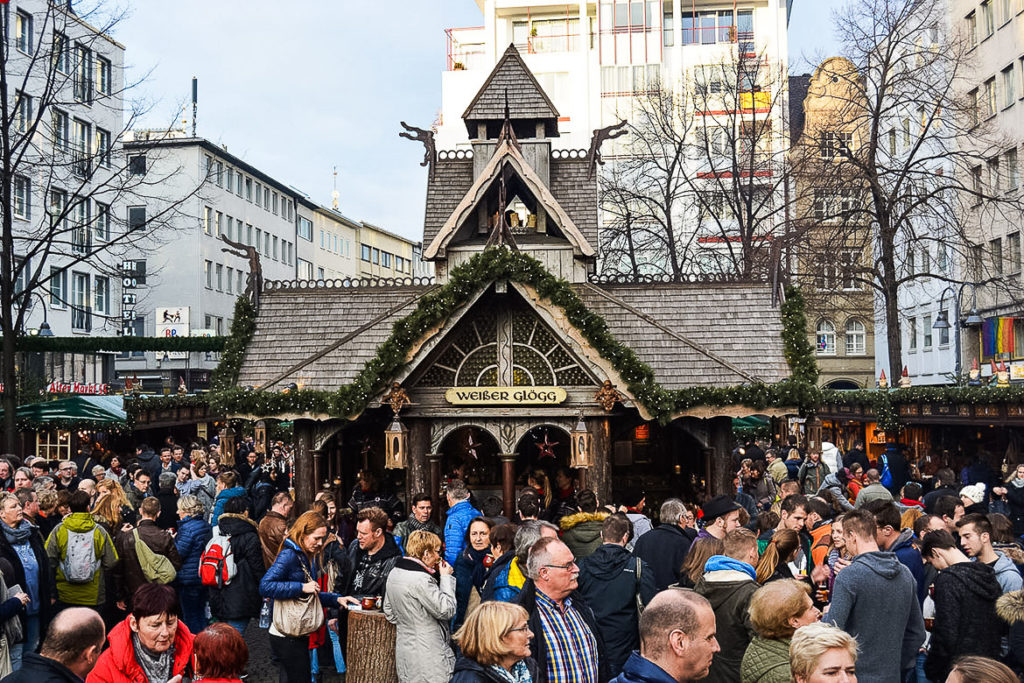
Most markets erect pop-up structures where they set up a restaurant or bar, which can be a welcome respite from the cold. Sometimes these are multiple stories and surprisingly elaborate inside. Just down the road from the Christmas market in Wiesbaden, there was a wooden chalet that was set up just for that period that housed a restaurant and bar, filled with cozy details like wool blankets and comfy pillows to lean against.
At many Christmas markets in Germany there are outdoor activities that visitors can partake in. The most common are skating rinks, where kids and adults alike zip around on the ice. Often, you are able to rent skates at the site if you are interested in participating.
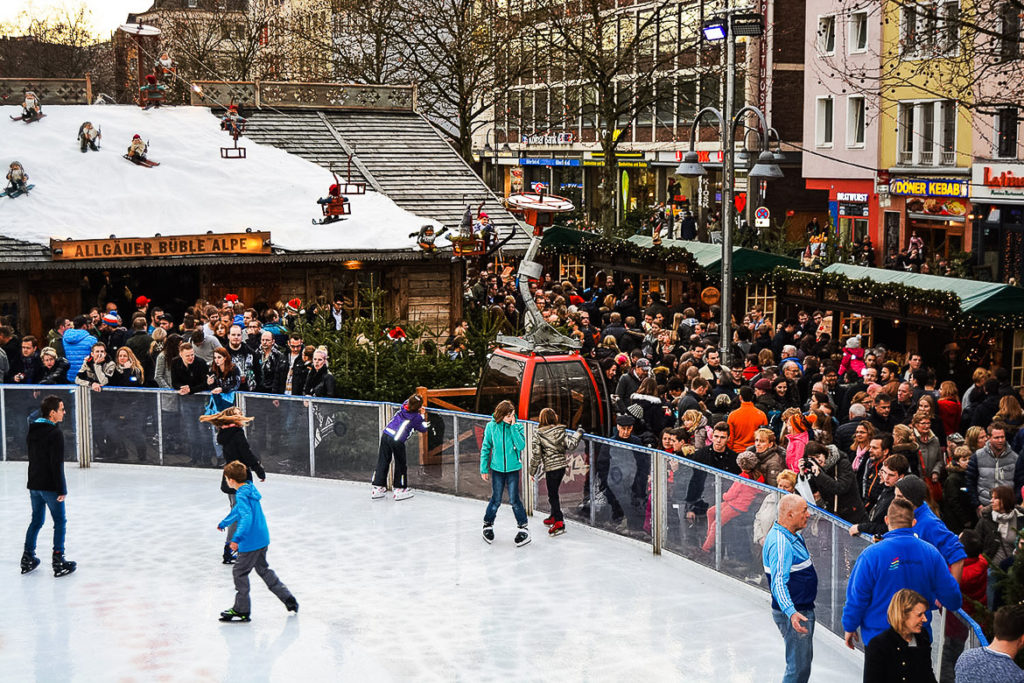
Cash is king across the various markets, with credit card rarely accepted. Be prepared with cash before you venture into a market as you’ll quickly be tempted to buy something. Seeking out an bank machine can be a long and arduous process.
They close early. Relatively speaking, Christmas markets in Germany close fairly early around 9 p.m., likely to keep it more of a family event and to ensure visitors don’t get too rowdy after multiple rounds of glühwein. Often everyone will wrap up and head home or to a spot nearby to keep the party going.
If you want to take in a few markets but don’t want to go it alone, there are tour operators that offer cruises along the Rhine or Danube rivers specifically to visit Christmas markets in Germany. If you prefer getting onboard with a tour, the more established cruise operators are Viking River Cruises and Avalon Waterways.
Christmas Markets in Germany to Visit:
Frankfurt
The Frankfurt Weihnachtsmarkt is one of the oldest in Germany with observances dating back to 1393. The modern day Christmas market stretches from the main train station throughout town, transecting several squares in the downtown core of Frankfurt. The heart of the market is the Römerberg in the centre of the altstadt, a large square with beautiful buildings including the town hall and Old St. Nicholas Church. You can’t miss the impressive two level Baroque carousel that’s a major draw for kids. For foodies, be sure to find the wood fired salmon, which is served on fresh buns with dill sauce as well as Bethmaennchen cookies made of marzipan and almonds.
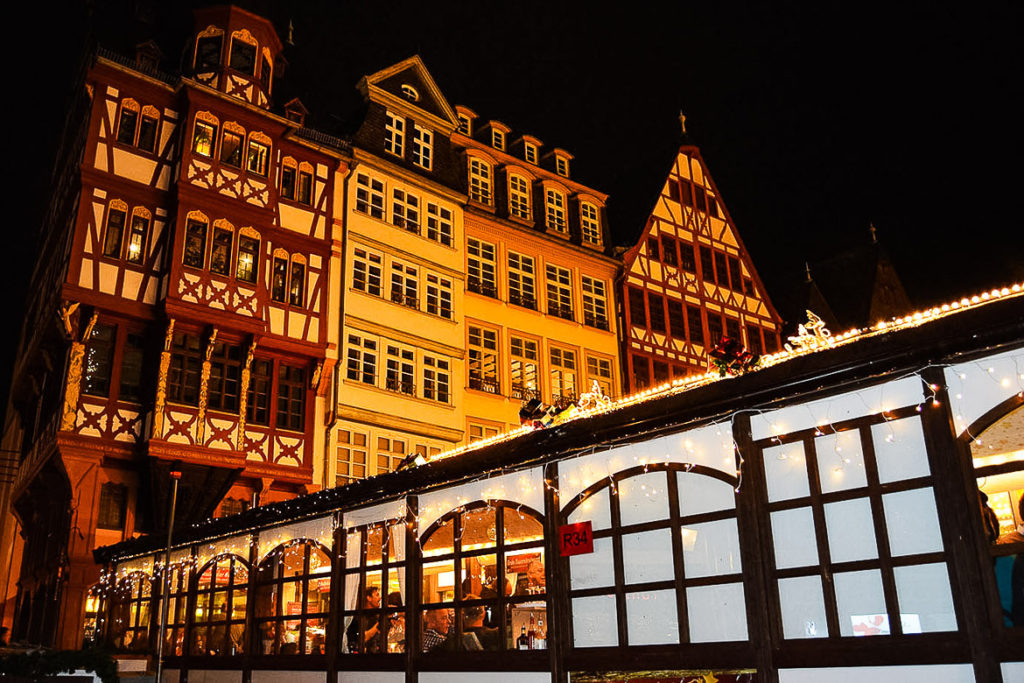
Darmstadt
Just a short trip from Frankfurt, Darmstadt is a market on a smaller scale but still has a ton to offer visitors. Darmstadt’s Weihnachtsmarkt takes up a significant portion of the town, with representation from many of its sister cities including Liepaja in Latvia, Gyoenk in Hungary, and Brescia in Italy. Save room for the flammeküeche, a thin flatbread topped with crème fraîche, chives, and bacon – it’s out of this world.
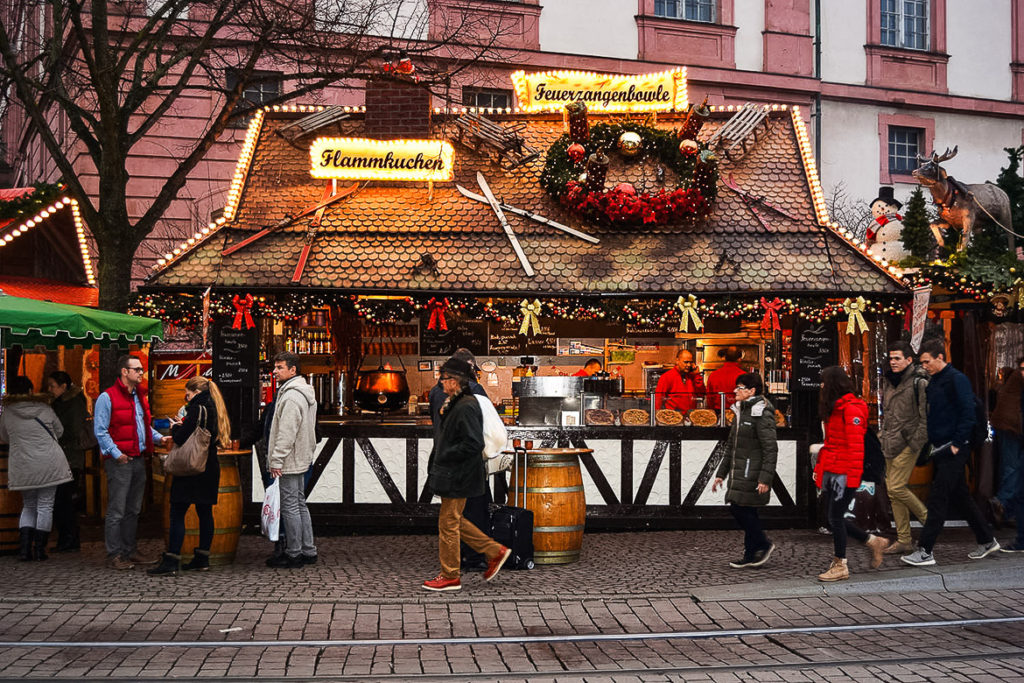
Aachen
The Christmas market in this Roman city and former Western European capital is especially popular with tourists given its central location near the borders of Belgium and the Netherlands. Check out the festival in the evening when the impressive Aachener Dom, northern Europe’s oldest cathedral, glimmers in the moonlight while singers serenade the crowd with festive music. Local speciality Printen, a sweet and spiced gingerbread cookie, is available all year round but feels extra special at this time of year.
Cologne
Cologne actually boasts seven markets scattered throughout the city, but the most prominent is near the Cathedral, adjacent to the old city. The Kölner Weihnachtsmärkte, featuring an enormous Christmas tree, is impressive. Legend has it that the Heinzelmännchen gnomes, who once upon a time would come out at night to make all of the goods produced in the city, are watching out for mass-produced items. Check out the market on the Rudolfplatz for a medieval fairy tale themed experience featuring the Brothers Grimm, Snow White, and Rumplestiltskin.
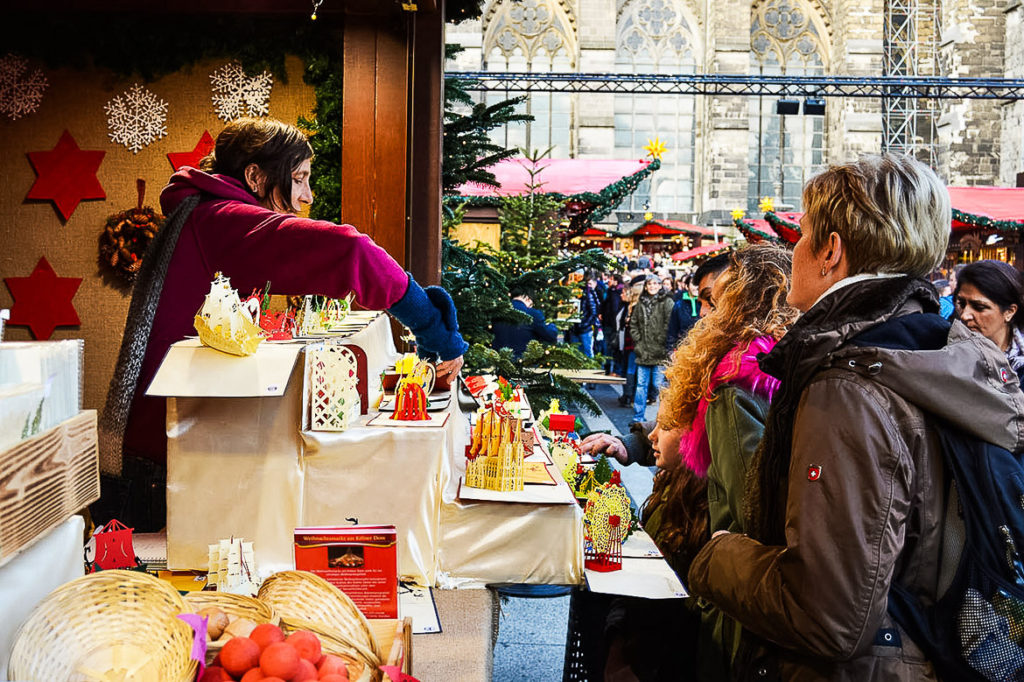
Dusseldorf
Like nearby Cologne, Dusseldorf boasts multiple Christmas markets throughout the city, the heart of which is in the Marktplatz and Burgplatz in the centre of the idyllic altstadt. A gigantic enclosed ferris wheel provides epic views over the market, the city, and the Rhine river. The beer halls nearby provide an excellent opportunity to warm up with an altbier or Dusseldorf’s special liqueur Killepitsch, made from nearly 100 different organic herbs, berries, and fruits.
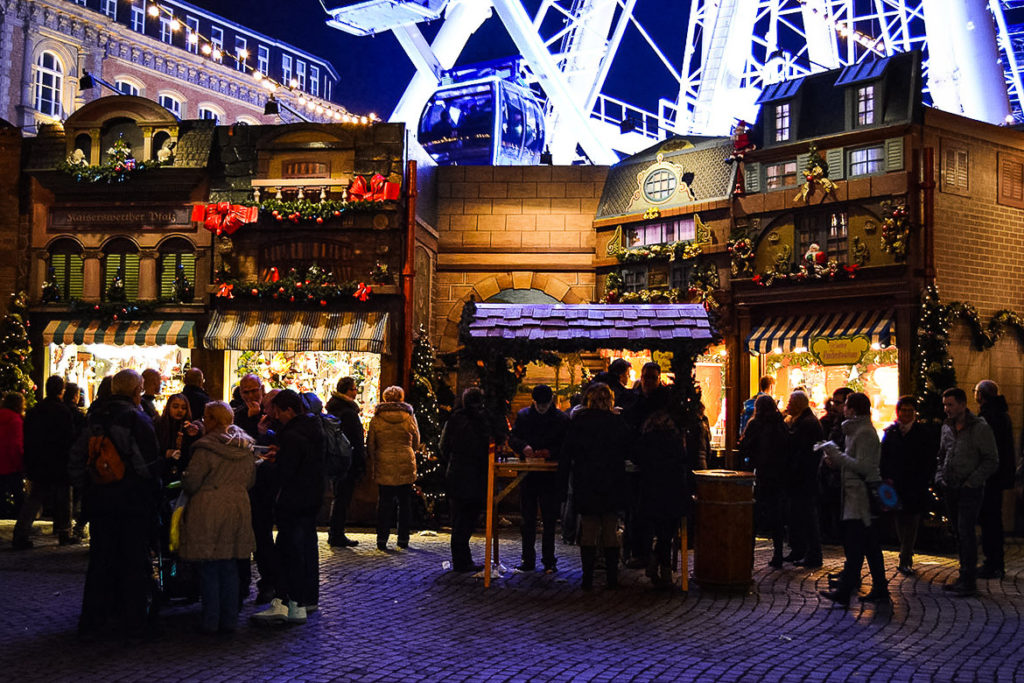
Hamburg
In Germany’s second largest city, the best elements from all local Christmas Markets are on display from Black Forest ornaments and Bavarian food, to printen from Aachen. This port city is known for being one of the more well-to-do spots in Europe and this extends to its Christmas festivities. The main market, located in the main plaza at the base of the town hall, features circus performers and a Christmas-themed parade every Saturday during the season. A great way to experience the beauty of the markets and the city is via an evening boat tour along the Alster.
Wiesbaden
The capital city of Hessen, Wiesbaden is a stone’s through from Frankfurt making it very accessible to visit. The city’s Christmas market is called Sternschnuppenmarkt, or twinkling star market, for good reason as it features thousands of lights and large installations that light up the central square of the city. While the typical Christmas drinks like gluhwein are featured, there are also plenty of stalls selling wine as this is a wine producing region of Germany. Also, be on the lookout for Henkell Trocken sparkling wine as the company has it’s headquarters in the city.
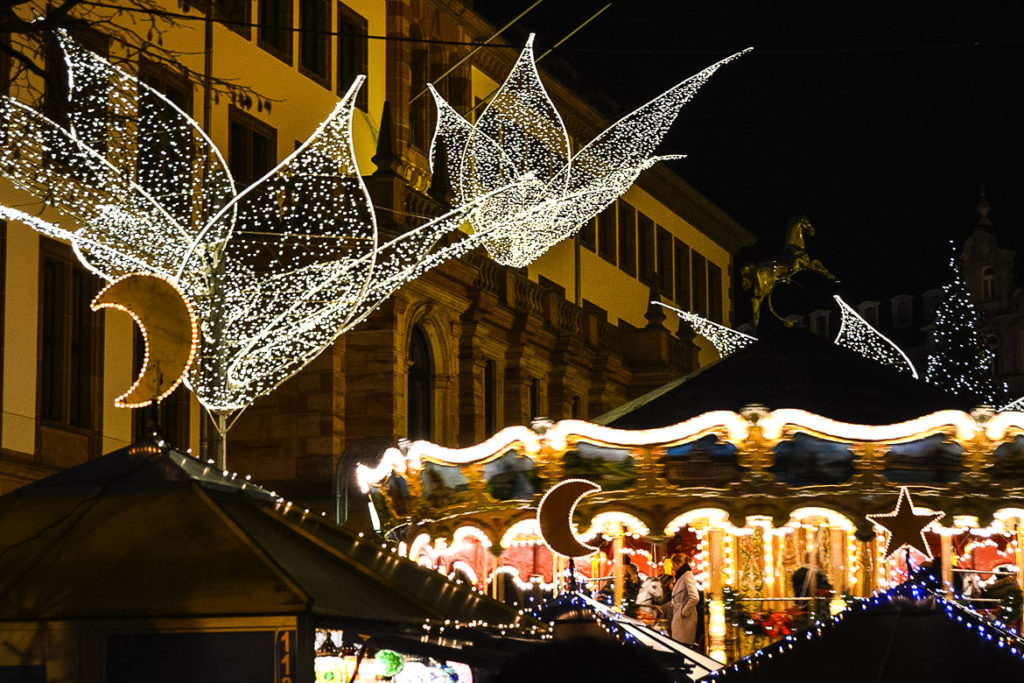
Mainz
Just a short train ride from Wiesbaden is Mainz, which features a stunning Christmas market set in its beautiful central square in front of St. Martin’s cathedral. A main attraction at the Mainzer Weihnachtsmarkt is the elaborate, multi level Christmas pyramid that overlooks the entire square. There’s lots of food on offer here but don’t miss out on the Reibekuchen, fried potato pancakes, which are available at most markets but are extra crispy and delicious in Mainz. If you’re with a group, try to snag one of the individual wooden huts that you can eat and have a drink in. Some have seats and benches but others offer standing room only.
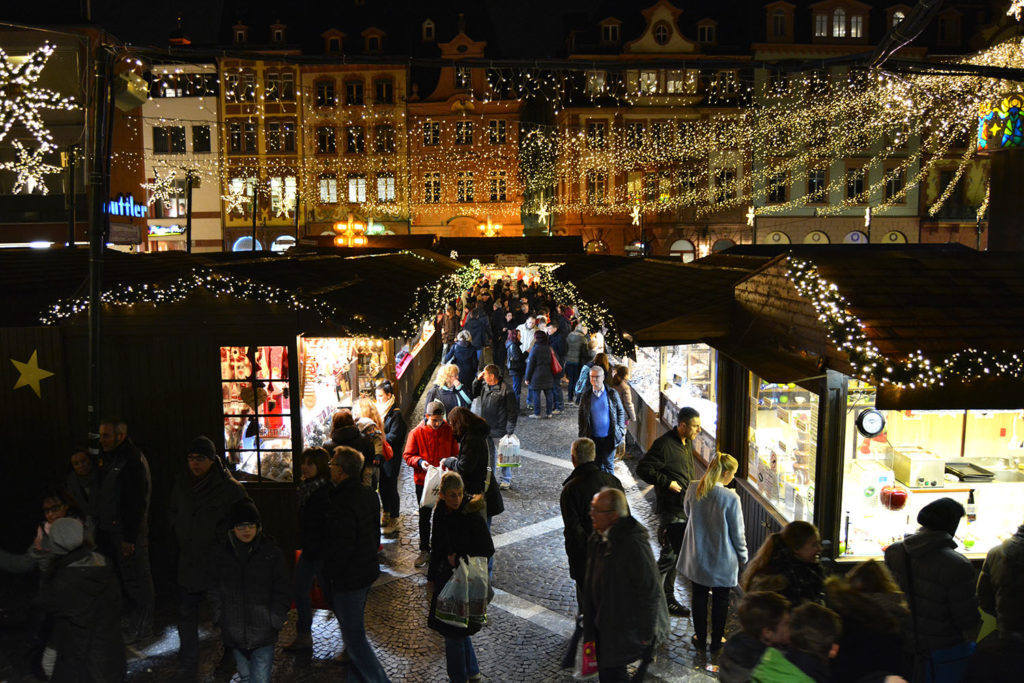
Freiburg
This picturesque city bordering the Black Forest knows how to celebrate Christmas. The market here in Freiburg, a university town, extends through much of the city, providing seemingly endless experiences. Traditional Xmas goodies such as freshly made beeswax candles, straw slippers, and unique holiday themed crafts are offered up by friendly business owners. Make sure to try a white wine version of glühwein before hitting up the town when the market closes.
Stuttgart
With nearly 300 stalls filled with unique goods to peruse and culinary delicacies to sample, the Stuttgarter Weihnachtsmarkt is a reason in and of itself to visit this city during the month leading up to Christmas. Self proclaimed to be one of the oldest Christmas markets in Germany and incorporating the most traditional elements of the holidays, this Christmas festival is a big draw. Every year booth owners try to outdo themselves, and their neighbours, to win the coveted ‘most beautiful stall’ award. The Wintertraum, which coincides with the Christmas Market, also offers some good winter fun with ice skating and warm treats. For a truly unique experience, make sure to check out nearby Esslingen, which hosts a medieval Christmas market.
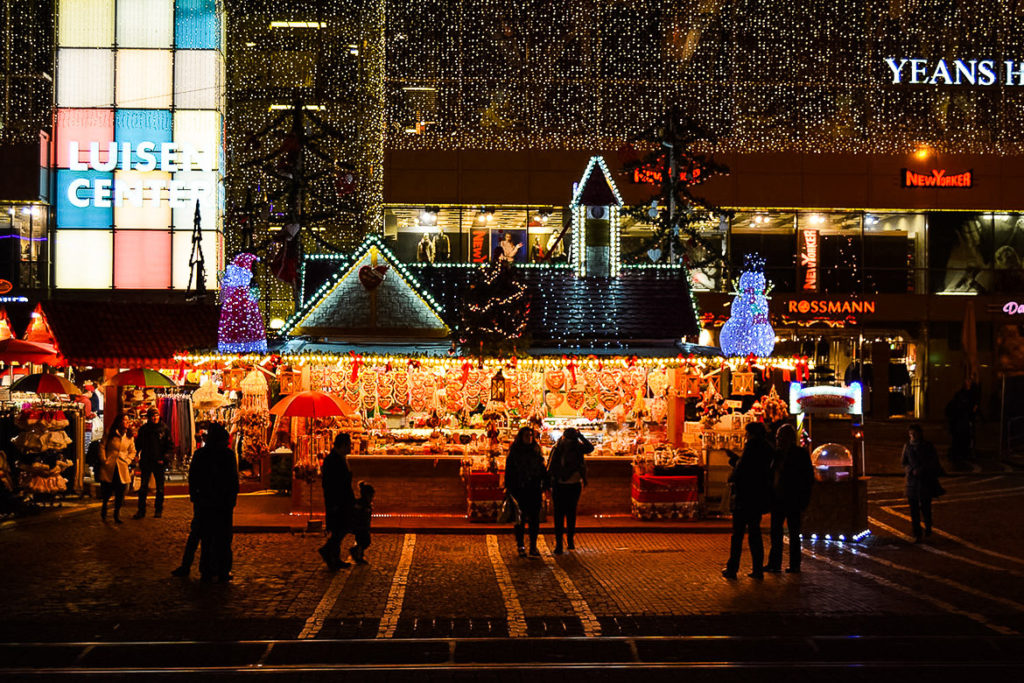
Munich
With a history dating back over 700 years, Munich’s Christkindlmarkt offers a traditional Bavarian experience. The main Christmas market occurs in the Marienplatz, with the impressive Rathaus (Town Hall) providing an epic backdrop to the festivities. There are several other holiday themed markets scattered across the city as well, so there’s bound to be something for everyone. Be on the look out for interesting wood carvings and blown glass from the Bavarian Forest, and make sure to stop by the Kripperlmarkt, or crib market, which features some of the most impressive nativity scene cribs and figurines you’ll ever find.
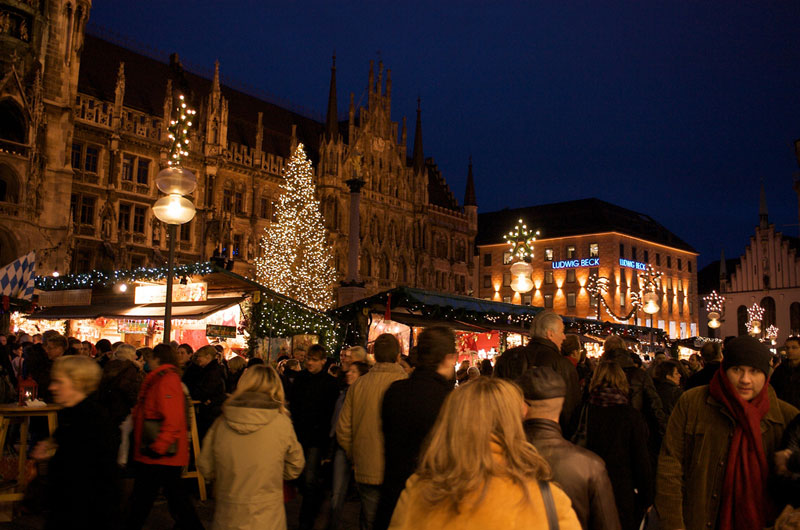
Nuremberg
Set in the town’s main square, Nuremberg’s Christkindlesmarkt is one of Germany’s largest Christmas markets attracting upwards of two million visitors annually. Each year, a young local girl is named ‘Christ Child’s Angel’ and serves as a tribute to the Christmas traditions of this city. For a unique gift, check out the Zwetcshgenmännle, essentially figurine people made of prunes in a wide array of eclectic costumes.
Berlin
Not surprising that the dynamic, multi-cultural, and impossible to peg down Berlin has close to sixty different Christmas markets located throughout the city, ranging from the traditional (Schloss Charlottenburg) to the upscale (Weihnachts-Rodeo). This makes market hopping a particularly great activity for anyone in Berlin over the holidays. Some of the most popular festivities occur at the Gendarmenmarkt, where you can indulge some beer, wine, or schnapps while marvelling at the enormous tree and enjoying the live entertainment on showcase throughout the season.
Dresden
The Christmas market in Dresden is one of the country’s oldest, dating back to the mid 15th century. The specialty here is hand-crafted wooden pieces from the Erzgebirge (Ore Mountains) such as nutcrackers, Christmas pyramid, and Raucherman (incense smokers resembling little men). Dresden’s main market, the Striezelmarkt, is centred in the Almarkt, the heart of the city. Just a few minutes away is a medieval market, or Mittelalter Weihnacht, which is perfectly on theme located in a stable yard and lit solely by lanterns.
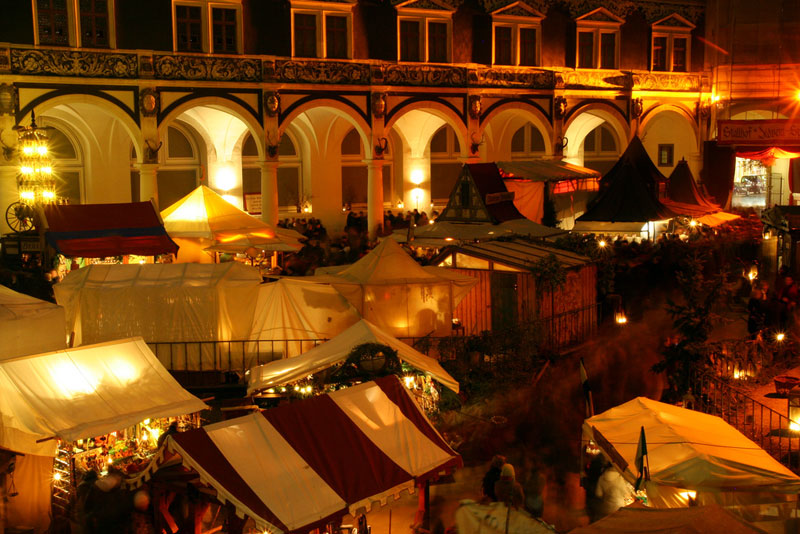
German Christmas Markets photo courtesy of JP Bervoets, Francois du Plessis, and Paleontour
Make your next trip the best one.
Departful is a full service travel agency creating truly exceptional travel experiences that are 100% personalized to you. Wherever you’re going, whatever your interests, we help you plan the perfect trip.
Lauren
Lauren co-founded Departful in 2012 and is the Managing Director of Departful Media. Since then she has worked between North America and Europe and has published content in partnership with a variety of tourism boards and businesses based around the world. Lauren is currently based in Toronto, Canada.


